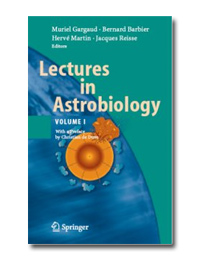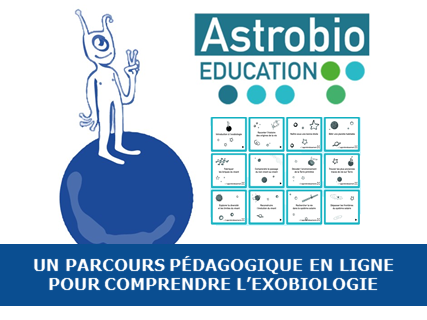Le premier tome de la série « Lecture in Astrobiology »-vol 1 est paru chez Springer. Il s’agit d’une traduction en anglais, avec mises à jour, d’articles parus dans les deux premiers tomes des ouvrages de cours des écoles d’exobiologie du CNRS, publiés aux Presses Universitaires de Bordeaux. Destiné à un large public international, cet ouvrage aborde les différents aspects de l’exobiologie : astronomie, géologie, chimie, biologie… Une version soft-cover en 2 volumes paraitra en fevrier 2006, et le volume 2 sortira fin 2006. Il est disponible chez Springer et chez les principaux marchands d’ouvrages sur Internet.
Téléchargez « Forword » (format PDF)
Téléchargez « La table des matières » (format PDF)
Téléchargez « La Préface par C. De Duve » (format PDF)
__________________________________________________
FOREWORD BY THE EDITORS :
Astrobiology, also known as bioastronomy or exobiology, refers to a vast area of scientific research. The formation of the Solar System, its accretion and the formation of the planets, the origin of the molecules out of which living beings are made, the traces of present and past life within the Solar System and elsewhere, as well as the search for extra-solar planets, are all part of astrobiology. And the above list is not exhaustive.
For obvious reasons, astrobiology is a field without the traditional barriers between astronomers, chemists, physicists, geologists, and biologists or between experimentalists and theorists, observers and those who model the observations. As such, a single researcher cannot possess all the knowledge necessary to be an “astrobiologist”. One can even go a step further and say that while astrobiology clearly exists, as a field of scientific research, there are no astrobiologists. Astrobiology exists at a higher level of organization where the knowledge is not that of an individual but that of a research community whose members all share the same interest for the fundamental questions concerning the emergence of life, its evolution, and how life is distributed on Earth and throughout the Universe. Each person contributes in piecing together this vast puzzle through their knowledge and their experimental and theoretical tools.
As often, if not always, when treating questions dealing with the past or with a sort of “elsewhere” where one cannot go and that one can only study indirectly, we must be satisfied with plausible scenarios rather than clear proof or other certainties. In this way, the strategy of the astrobiologist is similar to that of an archeologist or a paleontologist. There exists, however, major differences between the path of a chemist interested in the origin of life, and thus in prebiotic chemical evolution, that of a biologist wanting to follow time back starting with current life, and that of a paleontologist searching for the traces of primitive life and its evolution and extinctions.
While paleontologists have some hard data at hand (fossils and other physical traces), the situation is very different for chemists, who are obliged to build a plausible scenario for the appearance of life based on hypotheses developed by specialists in other fields (composition of the primitive terrestrial atmosphere, addition of extraterrestrial organic material, etc.). For the most part, these hypotheses are unverifiable. The biologist, on the other hand, tries to use phylogenetic tools to find and understand LUCA, the first common ancestor who must have been preceded by other micro-organisms with no descendants.
Similarly, there is an important difference between the strategies of a geologist, expert in the transition between the Tertiary and Cretaceous periods, and the planetologist who would like to describe the Earth during the period of intense meteoritic bombardment. The former disposes of observations and measures (iridium content, sediment ashes, shocked quartz, etc.), which provide a reasonable explanation for the great biological Cretaceous Tertiary crisis caused by a major meteorite impact. The latter only has access to indirect data based on observations of lunar craters but also simulations, which are of course based on theoretical models.
Since every scientist have recessarily a limited area of expertise, the scenario that he/she proposes can only be validated by the constraints and parameters that he/she knows and masters. Such an individual strategy can thus lead to as many scenarios as there are researchers. A multidisciplinary approach has the advantage of subjecting each individual proposition to a much larger number of constraints. This naturally leads to the rejection of “weak” scenarios and to the emergence of more robust hypotheses. For example, it is pointless for a chemist to invoke the role of a prebiotic chemical reaction if the conditions needed for the reaction to occur are completely incompatible with the primitive Earth conditions determined by the planetologists. This simple example illustrates the importance of interdisciplinary discussion for all those who consider themselves to be astrobiologists. The CNRS summer schools such as Propriano in 1999 and 2003 and La Colle-sur-Loup in 2001 have contributed to strengthen dialog within the French scientific community.
The goal of the first summer school, Exobio’99 in Propriano, was to provide participants with an objective image of what we know today about the early Earth conditions – the oceans, the proto-continents, the atmosphere, and even the climate – but also of what we know about the Solar System during the first billion years of its history. Some stages in the chemical evolution that may have occurred on the young planet Earth, with a different solar radiation, less intense in the visible part of the spectrum but much more intense in the RX region were also discussed during the first summer school. The discussion then moves towards the biological evolution, the early stages of which are still very poorly understood. The problems related to the exploration of Mars and Titan were then addressed.
The second summer school, Exobio ’01 in La Colle-sur-Loup, was more oriented towards the chemistry, molecular biology, biochemistry, and biological evolution of early Earth. Its main theme was the study of organisms referred to, as extremophiles, which could provide information on the nature of the first unicellular organisms that populated the young oceans. Among the specific topics addressed were the autoformation of biological membranes, the possible origins of the homochirality of the constituents of living beings, the protometabolisms that may be inferred from the study of metabolisms, and the possible role of ribozymes before the emergence of catalysis by proteinic enzymes.
The texts that follow represent the first volume of the series “Lectures in Astrobiology” and are the result of the first two schools. The chapters were written for readers already familiar with the general topic to the extend of which but not specialized in the issues of the origin of life and life “elsewhere” to the extend of which each specialist is, in his own discipline. As such, they are meant as much for students as for established scientists seeking to broaden their horizons in the vast field of the origins of life. We hope these texts will initiate vocations and incite researchers and students specialized in one of the individual fields to join the broad forum of astrobiology. It is undeniable that the questions that form the basis of astrobiology are among the big questions that humanity has asked itself since its inception and which recent decades have attempted to answer ; answers which seem more and more plausible although necessarily partial.
Muriel Gargaud
Bernard Barbier
Hervé Martin
Jacques Reisse






Aucun commentaire sur l'article Publication du premier tome de « Lectures in Astrobiology »